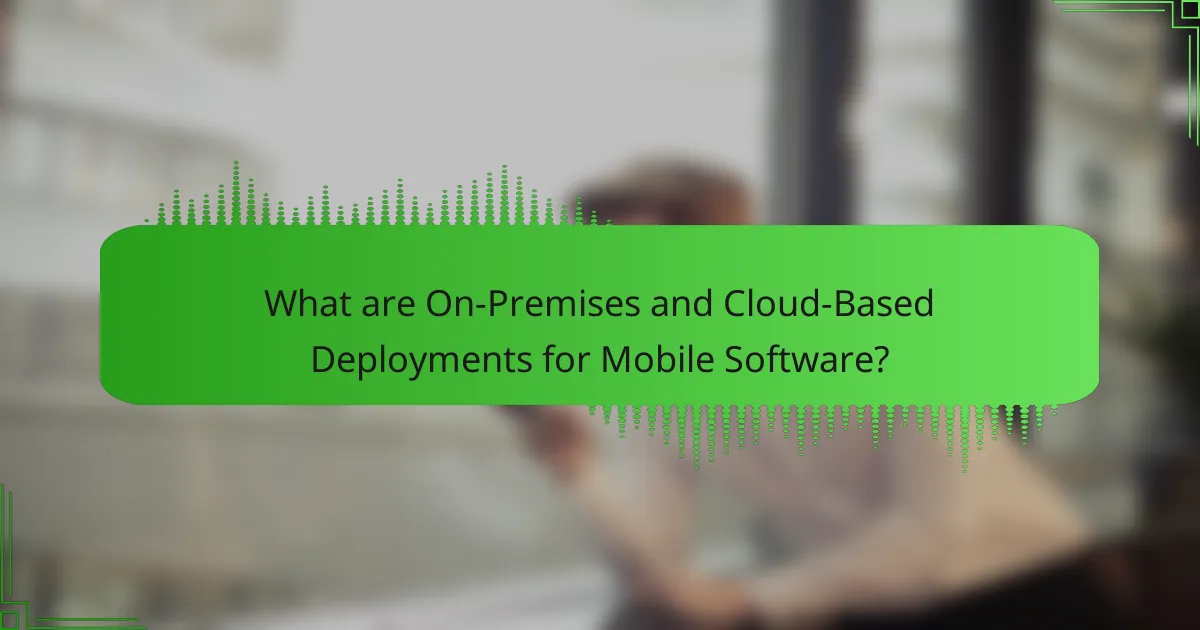This article compares on-premises and cloud-based deployments for mobile software, highlighting their distinct features and benefits. On-premises deployments involve installing software on local servers, providing organizations with direct control over data security, customization, and performance. In contrast, cloud-based deployments utilize remote servers, offering scalability, flexibility, and reduced IT overhead while enhancing collaboration and accessibility. The discussion will focus on how each deployment type meets different organizational needs and preferences, considering aspects such as security, cost, and operational efficiency.

What are On-Premises and Cloud-Based Deployments for Mobile Software?
On-premises deployments for mobile software involve installing and running the software on local servers within an organization’s infrastructure. This setup provides direct control over data and security. Organizations must manage hardware, software updates, and maintenance. In contrast, cloud-based deployments utilize remote servers hosted by a service provider. Users access the software over the internet. This model offers scalability, automatic updates, and reduced IT overhead. Cloud deployments often enhance collaboration by enabling access from various devices and locations. Both deployment types cater to different organizational needs and preferences.
How do On-Premises Deployments function?
On-premises deployments function by installing software directly on local servers within an organization. This setup allows companies to maintain control over their data and infrastructure. Users access the software through their internal network. On-premises solutions often require significant upfront investment in hardware and software licenses. Maintenance and updates are managed by the organization’s IT team. This model can offer enhanced security and compliance options. However, it may lack the scalability and flexibility found in cloud-based solutions. Organizations must weigh these factors when choosing a deployment method.
What are the key components of On-Premises Deployments?
The key components of On-Premises Deployments include hardware, software, network infrastructure, and security measures. Hardware refers to the physical servers and storage devices located on-site. Software encompasses the applications and operating systems installed on the hardware. Network infrastructure includes routers, switches, and firewalls that facilitate internal and external communication. Security measures involve firewalls, intrusion detection systems, and access controls to protect data. Each component must be managed and maintained by the organization’s IT team. This structure allows for greater control and customization compared to cloud-based solutions.
What are the typical use cases for On-Premises Deployments?
On-premises deployments are typically used in environments requiring strict data control and compliance. Organizations in regulated industries, such as healthcare and finance, often prefer on-premises solutions. This is due to the need for data security and adherence to regulations like HIPAA or GDPR. Businesses with legacy systems may also opt for on-premises deployments to maintain compatibility. Additionally, companies with limited internet connectivity find on-premises solutions more reliable. Customization needs drive some organizations to choose on-premises deployments for tailored solutions. Lastly, on-premises deployments are favored for applications that demand high performance and low latency.
How do Cloud-Based Deployments function?
Cloud-based deployments function by utilizing remote servers hosted on the internet. These servers store and manage data, applications, and services. Users access these resources via a web browser or application interface. This model allows for scalability, as resources can be adjusted based on demand. Cloud providers manage infrastructure, ensuring availability and security. According to Gartner, the cloud services market is expected to grow significantly, indicating its increasing adoption. This growth reflects the efficiency and flexibility that cloud-based deployments offer to businesses.
What are the key components of Cloud-Based Deployments?
The key components of cloud-based deployments include infrastructure, platform, and software services. Infrastructure as a Service (IaaS) provides virtualized computing resources over the internet. Platform as a Service (PaaS) offers a framework for developers to build applications. Software as a Service (SaaS) delivers software applications via the internet on a subscription basis. Additionally, cloud storage is essential for data management and backup. Security measures, such as encryption and access controls, protect data in the cloud. Scalability allows resources to be adjusted based on demand. Finally, network connectivity is crucial for accessing cloud services. These components collectively enable efficient and flexible cloud-based deployments.
What are the typical use cases for Cloud-Based Deployments?
Typical use cases for cloud-based deployments include software development and testing. These deployments allow teams to access resources on-demand. They facilitate collaboration among distributed teams. Cloud-based deployments enable scalable applications that can handle varying workloads. They also support data storage and backup solutions. Additionally, these deployments are commonly used for hosting websites and web applications. Businesses utilize cloud services for customer relationship management (CRM) systems. Finally, organizations leverage cloud solutions for big data analytics and machine learning applications.
What are the main differences between On-Premises and Cloud-Based Deployments?
On-Premises deployments involve hosting software on local servers. Cloud-based deployments utilize remote servers accessed via the internet. On-Premises solutions require upfront hardware and software investments. Cloud-based solutions typically operate on a subscription model. Maintenance for On-Premises systems is managed internally. Cloud-based systems are maintained by the service provider. Scalability is often easier with cloud solutions. On-Premises systems may require significant time for upgrades and scaling. Security responsibilities differ; On-Premises requires in-house management, while cloud providers handle it.
How do costs compare between On-Premises and Cloud-Based Deployments?
On-Premises deployments typically involve higher upfront costs compared to Cloud-Based deployments. On-Premises solutions require significant investments in hardware, software licenses, and maintenance. These costs can reach thousands to millions of dollars depending on the scale. In contrast, Cloud-Based deployments often utilize a subscription model, reducing initial expenses. Monthly or annual fees for cloud services can be more predictable and manageable for budgets. According to a study by Gartner, organizations can save up to 30% on IT costs by migrating to the cloud. This cost-effectiveness makes Cloud-Based solutions attractive for many businesses.
What are the security implications of each deployment type?
On-premises deployment offers greater control over data security. Organizations can implement custom security measures. This can reduce vulnerability to external threats. However, it also requires significant resources for maintenance and updates.
Cloud-based deployment provides scalability and flexibility. Security is managed by the service provider. This can lead to faster updates and patches. However, it also introduces risks related to data privacy and compliance.
Data breaches in cloud environments are often due to misconfigurations. According to a 2021 report by McKinsey, 60% of cloud breaches stem from user errors. Therefore, organizations must ensure proper training and governance.
In summary, on-premises deployment emphasizes control, while cloud deployment focuses on convenience. Each type has unique security implications that organizations must evaluate.

What are the advantages of On-Premises Deployments?
On-premises deployments offer enhanced control over data security and compliance. Organizations can manage their data within their own infrastructure. This reduces the risk of data breaches associated with third-party cloud services. On-premises solutions also allow for customization tailored to specific business needs. Additionally, they can provide lower long-term costs when avoiding ongoing cloud service fees. Performance can be optimized as resources are dedicated to a single organization. Lastly, on-premises deployments enable faster access to data without reliance on internet connectivity.
How does control and customization differ in On-Premises Deployments?
In on-premises deployments, control and customization are significantly greater compared to cloud-based solutions. Organizations can tailor the software to meet specific business needs without restrictions imposed by external vendors. This customization includes modifying software features, user interfaces, and integrations with existing systems. Control over data security and compliance is also heightened, as sensitive information resides within the organization’s infrastructure.
Additionally, companies can implement their own security protocols and access controls, which can be crucial for industries with stringent regulatory requirements. In cloud deployments, customization options are often limited by the provider’s framework and policies. Therefore, on-premises deployments provide a more flexible and controlled environment for organizations seeking specific configurations and enhanced data governance.
What specific customization options are available in On-Premises Deployments?
On-premises deployments offer various customization options tailored to organizational needs. Users can modify software configurations to align with specific business processes. They can also integrate third-party applications and tools to enhance functionality. Security settings can be customized to meet compliance requirements unique to the organization. Additionally, organizations can adjust user access controls based on roles and responsibilities. Custom branding options are available to reflect corporate identity. Data storage solutions can be tailored to fit organizational data management policies. These customization options provide flexibility and control over the deployment environment, catering to specific operational requirements.
How does data sovereignty impact On-Premises Deployments?
Data sovereignty significantly impacts on-premises deployments by dictating where data can be stored and processed. Organizations must comply with local laws that govern data privacy and security. This often requires on-premises solutions to be located within specific geographic boundaries. For instance, the European Union’s General Data Protection Regulation (GDPR) mandates that personal data of EU citizens be stored within the EU. Failure to comply can lead to substantial fines and legal repercussions. Additionally, data sovereignty influences the choice of technology and infrastructure used in on-premises deployments. Organizations may need to invest in local data centers or specific hardware to meet legal requirements. This can increase costs and complexity compared to cloud-based solutions. Overall, data sovereignty shapes both the operational and financial aspects of on-premises deployments.
What are the disadvantages of On-Premises Deployments?
On-premises deployments have several disadvantages. They require significant upfront capital investment for hardware and software. Maintenance and upgrades are the responsibility of the organization. This can lead to higher long-term costs. Scalability is often limited compared to cloud solutions. Organizations may struggle to quickly adapt to changing needs. Additionally, on-premises deployments can pose security risks if not properly managed. Disaster recovery solutions may also be less effective without proper infrastructure. These factors can hinder overall operational efficiency.
How do maintenance and support challenges affect On-Premises Deployments?
Maintenance and support challenges significantly impact on-premises deployments. These challenges often lead to increased downtime due to hardware failures or software issues. On-premises systems require dedicated IT staff for regular maintenance, which can strain resources. Limited vendor support for legacy systems can complicate troubleshooting. Additionally, organizations may face higher costs for in-house maintenance compared to cloud solutions. Data security and compliance issues can arise without proper support. Organizations must also invest in training staff to manage these systems effectively. Consequently, these factors can hinder operational efficiency and scalability.
What are the scalability limitations of On-Premises Deployments?
On-premises deployments have significant scalability limitations. They require substantial hardware investments for expansion. Upgrading infrastructure can be costly and time-consuming. Limited physical space can restrict growth potential. Additionally, on-premises solutions often lack the flexibility of cloud-based options. Scaling up usually involves purchasing new servers and software licenses. This process can lead to longer deployment times compared to cloud solutions. As a result, businesses may struggle to adapt to changing demands efficiently.

What are the advantages of Cloud-Based Deployments?
Cloud-based deployments offer scalability, flexibility, and cost-effectiveness. Organizations can easily adjust resources based on demand. This adaptability supports varying workloads without the need for significant infrastructure changes. Additionally, cloud solutions often reduce upfront capital expenses. Businesses can operate on a pay-as-you-go model, optimizing budget allocation. Enhanced collaboration is another advantage, as teams can access applications and data from anywhere. Security measures in cloud environments are typically robust, with advanced protocols in place. Regular updates and maintenance are managed by service providers, ensuring systems stay current. Overall, these factors contribute to improved operational efficiency and innovation.
How does scalability work in Cloud-Based Deployments?
Scalability in cloud-based deployments allows resources to be adjusted based on demand. This means that as user traffic increases, additional resources can be provisioned seamlessly. Cloud providers typically offer auto-scaling features that automatically manage resource allocation. This ensures optimal performance without manual intervention. Conversely, during low-demand periods, resources can be scaled down to save costs. A report by Gartner indicates that cloud scalability can reduce infrastructure costs by up to 30%. This flexibility is a key advantage over traditional on-premises solutions, which require significant upfront investment for capacity that may not always be utilized.
What are the implications of on-demand resource allocation in Cloud-Based Deployments?
On-demand resource allocation in cloud-based deployments allows for dynamic scaling of resources based on real-time needs. This flexibility leads to cost efficiency, as organizations pay only for resources they use. It enhances performance by automatically adjusting resources during peak loads. Additionally, it improves resource utilization, minimizing waste and optimizing operations. Security concerns may arise due to shared resources in multi-tenant environments. However, cloud providers implement robust security protocols to mitigate risks. The implications also include increased agility, enabling faster deployment and innovation cycles. Overall, on-demand resource allocation significantly impacts operational efficiency and strategic planning in mobile software development.
How does Cloud-Based Deployment facilitate remote access?
Cloud-based deployment facilitates remote access by enabling users to connect to applications and data over the internet. This model allows access from any device with an internet connection. Users can work from various locations without being tied to a specific network. Cloud services utilize data centers that host applications, making them accessible globally. This setup supports collaboration among remote teams efficiently. According to a report by Gartner, cloud adoption increases flexibility and scalability, further enhancing remote work capabilities.
What are the disadvantages of Cloud-Based Deployments?
Cloud-based deployments have several disadvantages. One major issue is dependency on internet connectivity. If the internet is slow or down, access to applications and data can be severely hindered. Security concerns also arise, as data stored in the cloud may be more vulnerable to breaches. Additionally, compliance with regulations can be challenging, especially for industries with strict data protection laws. Cost can escalate over time due to subscription fees and data transfer charges. Vendor lock-in is another risk, making it difficult to switch providers or migrate to another platform. Finally, limited control over infrastructure can lead to performance issues that are not easily resolved.
How do potential data privacy concerns affect Cloud-Based Deployments?
Potential data privacy concerns significantly affect cloud-based deployments. These concerns lead organizations to hesitate in adopting cloud solutions. Data breaches can expose sensitive information, resulting in regulatory penalties. According to a 2021 IBM report, the average cost of a data breach is $4.24 million. Additionally, compliance with regulations like GDPR and HIPAA complicates cloud usage. Organizations must ensure that cloud providers meet stringent security standards. The lack of control over data location and access increases risk perceptions. Consequently, companies may prefer on-premises solutions for better data governance.
What are the risks of vendor lock-in in Cloud-Based Deployments?
Vendor lock-in in cloud-based deployments poses several risks. It restricts organizations from easily switching providers due to proprietary technologies. This can lead to increased costs for migration or continued dependency on a single vendor. Additionally, vendor lock-in can limit flexibility in scaling resources or integrating with other services. Organizations may face challenges in negotiating pricing and service terms. A study by Gartner indicates that 75% of organizations experience difficulties when attempting to migrate away from a cloud vendor. The lack of interoperability can hinder innovation and responsiveness to market changes. Overall, vendor lock-in can result in reduced agility and increased long-term expenses.
What factors should organizations consider when choosing between On-Premises and Cloud-Based Deployments?
Organizations should consider factors such as cost, scalability, security, and control when choosing between On-Premises and Cloud-Based Deployments. Cost involves initial setup and ongoing maintenance for On-Premises solutions versus subscription fees for Cloud services. Scalability is easier with Cloud solutions, allowing organizations to adjust resources as needed. Security is a concern as On-Premises deployments offer direct control, while Cloud solutions depend on the provider’s security measures. Control over data and compliance requirements may favor On-Premises for certain industries. Additionally, integration with existing systems can influence the decision, as some organizations may find it easier to integrate On-Premises solutions.
How do organizational needs influence the choice of deployment type?
Organizational needs significantly influence the choice of deployment type for mobile software. Specific requirements such as data security, compliance, and budget constraints affect this decision. For example, organizations handling sensitive data may prefer on-premises deployment for enhanced security control. Conversely, businesses seeking scalability and cost-effectiveness often opt for cloud-based deployment. According to a 2022 Gartner report, 70% of organizations prioritize flexibility in their deployment choice. Additionally, the need for remote access and collaboration drives many to choose cloud solutions. Thus, organizational needs directly shape the strategic decision-making process regarding deployment types.
What role does budget play in selecting a deployment model?
Budget plays a critical role in selecting a deployment model. It influences decisions on whether to choose on-premises or cloud-based solutions. On-premises deployments often require significant upfront capital investment for hardware and licenses. In contrast, cloud-based models typically operate on a subscription basis, reducing initial costs. Organizations with limited budgets may favor cloud solutions for their lower entry barriers. Additionally, ongoing operational costs differ; on-premises systems incur maintenance expenses, while cloud services may include these in the subscription fee. Therefore, budget constraints directly affect the feasibility and sustainability of the chosen deployment model.
What best practices can guide the deployment decision process?
Best practices for the deployment decision process include assessing organizational needs, evaluating cost implications, and considering scalability. Organizations should analyze their specific requirements before choosing a deployment model. Cost analysis helps in understanding the financial impact of on-premises versus cloud solutions. Scalability considerations ensure that the chosen deployment can grow with the organization. Additionally, security requirements must be evaluated to protect sensitive data. Performance and reliability are also critical factors in the decision-making process. Engaging stakeholders throughout the process fosters alignment and informed choices. Finally, reviewing case studies and industry benchmarks can provide valuable insights.
How can organizations assess their specific requirements for deployment?
Organizations can assess their specific requirements for deployment by conducting a thorough needs analysis. This analysis should include evaluating current infrastructure capabilities. Organizations must identify their budget constraints and performance expectations. They should also consider compliance and security requirements relevant to their industry. Engaging stakeholders in discussions can provide insights into functional needs. Additionally, organizations can benchmark against similar deployments in the industry. Gathering feedback from end-users will help refine requirements further. Utilizing assessment frameworks can streamline the evaluation process.
What steps can be taken to ensure a smooth transition between deployment models?
To ensure a smooth transition between deployment models, organizations should conduct thorough planning and assessment. This involves evaluating the current infrastructure and identifying the necessary resources for the new model. Communication with stakeholders is critical to align expectations and responsibilities. Training for staff on the new deployment model enhances adaptability. Data migration should be meticulously planned to avoid loss or downtime. Testing the new model in a controlled environment helps identify potential issues. Establishing a rollback plan ensures quick recovery if problems arise. Monitoring performance after the transition is essential to address any emerging challenges. These steps are supported by industry best practices in change management and deployment strategies.
The main entity of the article is the comparison between On-Premises and Cloud-Based Deployments for Mobile Software. The article provides a detailed examination of both deployment types, discussing their functionalities, key components, advantages, and disadvantages. It highlights how On-Premises deployments allow for greater control and customization, while Cloud-Based deployments offer scalability and cost-effectiveness. Additionally, the article addresses factors influencing the choice between the two models, such as budget, security, and organizational needs, along with best practices for assessing requirements and ensuring smooth transitions.


